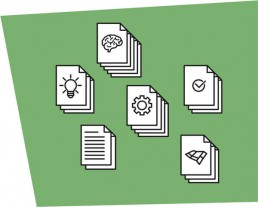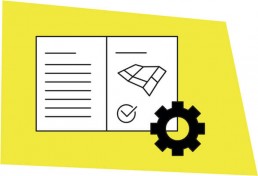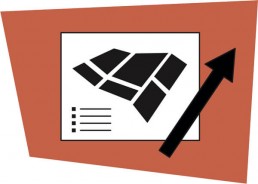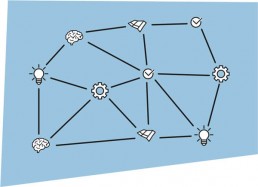What is MinLand about?
The MINLAND project has been designed to meet challenges concerning competing land-use planning related to different land-use interests.
Competition about use of land is fierce within Europe. Currently, the need for metals, construction raw materials and industrial minerals is increasing. There is a large need for access to land for exploration and extraction of mineral raw materials, including critical raw materials. MINLAND aims to secure access to land, with actual or potentially valuable resources, for exploration and extraction of minerals, in an integrated and optimised process, within the EU.
The EU has recognised the need for shared guidelines about harmonised land use and the need for mineral policy strategies within Europe. MINLAND offers an answer to these challenges and is therefore rewarded with an EU Horizon2020 grant for the coming 24 months.
Objectives
The overarching objectives of the MinLand project
The main goal for the MINLAND project is to ensure access to areas with actual or potentially valuable resources for mineral exploration and exploitation activities within the EU. Exploration and exploitation are required in order to secure European access to necessary raw materials, including critical raw materials (CRM). In order to achieve this goal the proposed MINLAND project will pursue four overarching objectives:
Objective 1 «create a knowledge repository»
A comprehensive and structured data base with current policies, case studies and best practices about land use planning will be created. These will cover the process from exploration to mining to re-use of post-mining area. Further a reference to existing data repositories and earlier and ongoing EU projects will be included.


Objective 2 «facilitate minerals and land use policy making»
Develop practitioner guidelines for linking land use- and mineral policies; linking implications for land use planning and mineral deposits of public importance (MDoPI), with safeguarding of mineral raw materials within EU. We will elaborate on solutions to safeguarding land for mineral exploration and exploitation versus other land uses.
Objective 3 «strengthen transparent land use practices»
A clear overview will be created of: adequate land use data; adequate geological information; INSPIRE compatibility; necessary information; necessary tools; necessary instruments, such as PERC and UNFC, FRB, etc. Analyses of case studies addressing these issues will provide input for the design of a selection of best practices. Conclusions and information gathered within the project will provide an important source at local, regional, national and EU-scale, for transparent land use practices.


Objective 4 «foster networking»
Relevant stakeholders will be identified among the practitioners (i.e. land-use planners and mining authorities at local, regional and national levels etc.) and will be included in an interactive and open participation process, ensuring knowledge exchange and continuous learning, and supporting the dissemination of good practices.
These overarching objectives are mutually supportive and can be further broken down into specific sub-objectives that are described in the following paragraphs. Each sub-objective is addressed by one or more of the project’s work packages, as shown in the table below.
Work Packages
WP1 Management
This work package is in charge of the leadership, coordination and project management tasks, including organizing the consortium meetings, steering the Management Committee, coordinating the reporting, and consulting with the advisory board. All participants are required to adhere to the project management procedures. The purpose of work package 1 is to lead, manage, coordinate and monitor the progress of the project, and ensure that the project meets the objectives stated for the work described in the Grant Agreement and that WP leaders and partners respect the timeline and deliverables. Reporting and consulting with the Advisory Board is summarized in the following two work tasks.
WP2 Land Use Planning Policies & Practices
WP2 will collect and structure data on mineral deposits and land use in Europe, by investigating existing policies and practices, and relevant data repositories. Policies and practices on mineral resources versus other land use will be investigated across different policy levels from regional to national to Pan-European. WP2 will build upon previous projects, such as Minatura2020, MINGUIDE and MINLEX studies.
WP3 Case studies of land use planning in exploration and mining
This WP will use selected case studies concerning the relation of mineral raw materials and associated industries with land use planning to compile indications on how the raw materials are integrated into land use planning regulations and guidance in Europe. The achievements will be further developed in other project actions to build up proposals for best practices on safeguarding resources and ensuring subsequent improved utilization of mineral raw materials throughout EU Member States in the future.
The main objective of WP3 is to carry out surveys on how mineral resources and extractive industries are currently taken into account in national, regional and local land use planning processes across the EU Member States. For this purpose, selected case studies will cover targets in several phases along the mineral raw materials value chain, namely exploration, exploitation and rehabilitation stages, as well as areas of potential mineral resources. Documentation related to each case study will be collated.
WP 4: Land use practices, valorisation and valuation of geological and societal data and civil society impacts
Building on results from work packages 2 and 3, this work package will provide an in depth analysis of key elements in land use practice with the purpose of defining and making comparable the value of land, including valorisation and mineral classification schemes, valuation (economic, environmental and social) of other land uses and the impact of civil society. It will:
- Investigate existing valorisation / classification schemes used across Europe on how they are deriving value (incl. economic, social and environmental dimensions) to mineral deposits, which is necessary for further evaluation (i.e. establishment of mineral deposits of public importance (MDOPI) and potential later safeguarding – see work package 5).
- Investigate how valuation (incl. economic, social and environmental dimensions) of other land use options is done in land use planning across Europe.
- Create a structured comparison of the two approaches, check if they are on equal ground and identify success factors for the integration from good practise examples.
- Investigate how civil society can impact land use practice in terms of being a factor that will allow or stop mineral or other land use options.
WP 5 Common Framework for natural resources planning
This Work package aims to use the common framework from MINATURA 2020 with a view ensure the accessibility of mineral resources in a wider sustainable and societal development context. The objectives of this WP are:
- to elucidate the epistemology and rationale for making provisions for the future over long time-horizons with a view to arrive at a clear understanding of the relevant factors and societal actors.
- to make the rationale for including mineral resources safeguarding into land-use planning transparent to all stakeholders
- to be able that other stakeholders can update the recommendations and assess feasibility of implementation elsewhere.
WP 6 Practitioner Guidelines and peer-learning
WP6 will synthesize and contextualize the project’s good practice examples (WP2, 3, 4, 5) and, thus, provide useful and comprehensive guidance for EU MS peer practitioners in public policy, land use planning, geological survey, industry, civil society and other groups. To achieve a useful and fit-for-purpose knowledge exchange and learning experience for peers, this WP will manage the process of peer learning to design, elaborate and finalize good practice guidance documents: WP 6 will organize the process to synthesize in-depth information on project outputs and increase their context-relevance by discussing and exchanging peer perspectives and hands on knowledge at 8 local peer-learning Workshops. The combined results of peer input at workshops and of fact-finding stakeholder interviews and surveys will feed into a final Manual for practitioners D6.2: Good Practice Guidance Synthesis Report. WP6 is strongly interlinked with the work carried out in WPs 2-5 and WP7.
WP 7 Land Use Planning Network and Clustering activities
Network creation with the stakeholders on land use planning and mineral policies. The main aim of this pillar is to identify the Expert Network on Land Use Planning and to engage a critical mass of actors and stakeholders covering the spectra of land use planning and mineral policy activities both on EU and on Member State level.
Clustering activities with other relevant past, ongoing and future Horizon 2020, EIT RawMaterials and other EU policy projects. The main objectives of this pillar will be:
- to facilitate a consensus on mineral policy making along the different past, ongoing and future projects from Horizon 2020, EIT RawMaterials and other EU or National policy project;
- to avoid duplication of work and improve efficiency;
- to provide a forum for discussion, problem solving and planning policy making activities and gaps in Europe;
- to allow the projects to report on success and allow for an assessment of the impact achieved;
- to identify cross cutting issues and to share best practices among the different projects.
WP 8 Communication, dissemination and exploitation
The objective of WP8 is to widely disseminate the project results during the project life-span as well as to maximize its impacts after the end of the project.
WP8 will focus in developing and implementing a comprehensive communication strategy plan that will define the project multiple stakeholders and the most suitable channels to reach them. WP8 will support the project Work Packages in communicating their research in an understandable way for scientific and no-scientific audiences. In particular, WP8 will:
- Disseminate information on the project, its progress and results to the wider community operating in the field of mineral policies and land management in the EU and beyond, including national, local, regional public authorities, other interested third parties and the general public;
- Ensure that the project benefits are clearly and systematically promoted, and foster a two-way dialogue with stakeholders;
- Raising awareness and visibility on the importance of improving Europe’s framework conditions for sustainable access and supply of Raw Materials, including Critical Raw Materials (CRM);
- Fostering the connection with existing EU and Member States initiatives and projects relevant to the Project outcomes.
